Hiking Mount Emei: Tips and Trails for an Unforgettable Experience
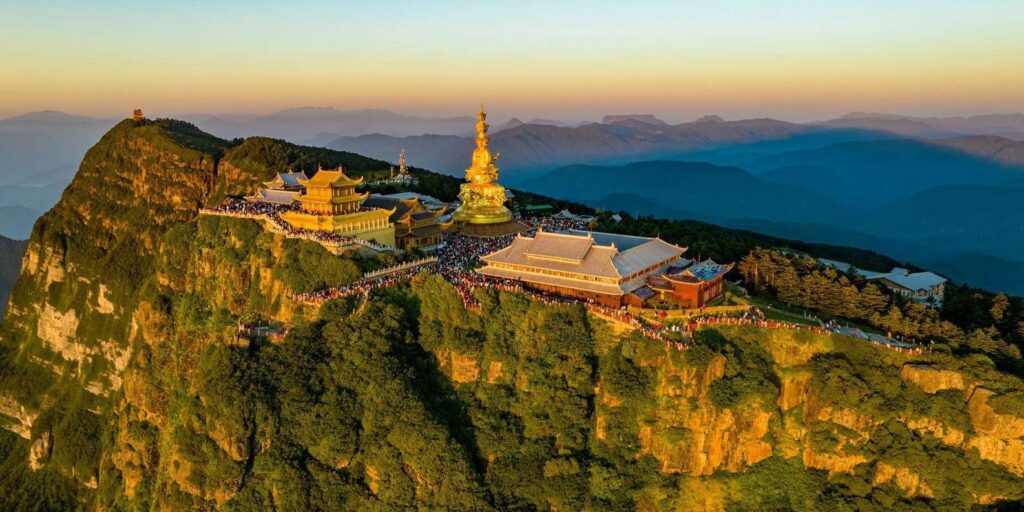
An Essential Guide to Visiting Mount Emei
Nestled in the heart of Sichuan Province, Mount Emei (峨眉山) stands as a testament to the breathtaking beauty of China’s natural landscapes and deep-rooted Buddhist culture. As one of the Four Sacred Buddhist Mountains, this UNESCO World Heritage Site draws countless travelers each year, eager to experience its majestic peaks, tranquil temples, and rich biodiversity.
A journey to Mount Emei invites you to traverse an enchanting tapestry of lush forests, meandering streams, and panoramic vistas, all while immersing yourself in the spiritual essence that permeates its ancient temples. The mountain is not merely a visual feast; it is a living museum, home to over 300 monks and nuns who continue the age-old traditions of meditation and worship, surrounded by the whispers of nature.
The allure of Mount Emei lies not only in its stunning scenery but also in the diversity of experiences it offers. Whether you wish to hike to the revered Golden Summit to witness the breathtaking sunrise or indulge in the soothing warmth of its hot springs after a day of exploration, Mount Emei caters to every traveler’s desires. For those seeking adventure, the mountain’s trails lead to hidden gems like the Ecological Monkey Zone, where playful monkeys frolic amidst the trees.
As you prepare for your adventure, this essential guide will equip you with all the information you need to navigate this incredible destination, ensuring that your visit to Mount Emei is both memorable and transformative. From transportation tips and the best times to visit, to must-see attractions and accommodation options, get ready to embark on a journey that will leave you inspired and connected to the wonders of nature and spirituality.
In This Guide
- An Essential Guide to Visiting Mount Emei
- The Rich History and Legends of Mount Emei
- Main Highlights: What You Absolutely Can’t Miss
- Planning Your Visit: A Practical Guide
- Tickets: Prices, Booking, and Tips
- How to Get There: A Complete Transportation Guide
- Local Cuisine and Accommodation Nearby
- Frequently Asked Questions
- Final Thoughts on Your Trip
The Rich History and Legends of Mount Emei
Mount Emei, a majestic peak nestled in the heart of Sichuan Province, boasts a rich tapestry of history and legends that have woven the mountain into the fabric of Chinese culture for centuries. Revered as one of the Four Sacred Buddhist Mountains in China, it is not just a site of natural beauty but a hallowed ground steeped in spiritual significance and mythological tales.
The documented history of Mount Emei dates back over 2,000 years, with its earliest mention in the Han Dynasty (206 BCE – 220 CE). Ancient texts describe it as a site where monks and scholars would gather for meditation and philosophical discussions. By the time the Tang Dynasty (618 – 907 CE) rolled around, Mount Emei had solidified its status as a key center for Buddhist thought and practice. It became the ashram for Samantabhadra Bodhisattva, a revered figure in Mahayana Buddhism known for his compassion and wisdom.
One of the most iconic legends associated with Mount Emei is that of the Buddha’s halo, an ethereal phenomenon best witnessed at its Golden Summit. According to lore, when the sun rises and casts its rays upon the summit, the light refracts through the moisture in the air, creating a rainbow-like halo around a person’s shadow on the clouds below—a sight that has captivated countless visitors and pilgrims alike.
The mountain is home to about 30 temples, each with its own unique history and architectural style. Among them, the Baoguo Temple, established during the Ming Dynasty, serves as the mountain’s gateway and is the spiritual hub for the Buddhist community on Emei. It houses numerous cultural relics and is a testament to the rich architectural heritage that has evolved over the centuries.
The stories of the monks who have dedicated their lives to the spiritual cultivation on Mount Emei add to its mystique. These monks, often seen in traditional robes, continue to practice their faith in the tranquil surroundings, maintaining the mountain’s ancient rituals and traditions. The presence of these monks, along with the serene ambiance of the temples, creates an atmosphere that transports visitors back in time, allowing them to connect with the mystical energy that permeates the air.
Throughout history, Mount Emei has also been a source of inspiration for poets, artists, and philosophers. Its breathtaking vistas, filled with lush greenery, mist-shrouded peaks, and vibrant flora and fauna, have inspired countless works of art and literature, celebrating not only the mountain’s beauty but also its spiritual essence.
Even today, Mount Emei remains a powerful symbol of harmony between nature and spirituality. Its UNESCO World Heritage status, granted in 1996, recognizes not only its stunning natural environment but also its profound cultural significance. Visitors from around the globe are drawn to this sacred mountain, eager to experience its rich history, hear its legends, and bask in its serene beauty.
In a world that often feels fast-paced and disconnected, Mount Emei offers a refuge—a place where the past meets the present, and where the whispers of ancient legends can still be heard in the rustle of leaves and the gentle flow of waterfalls.
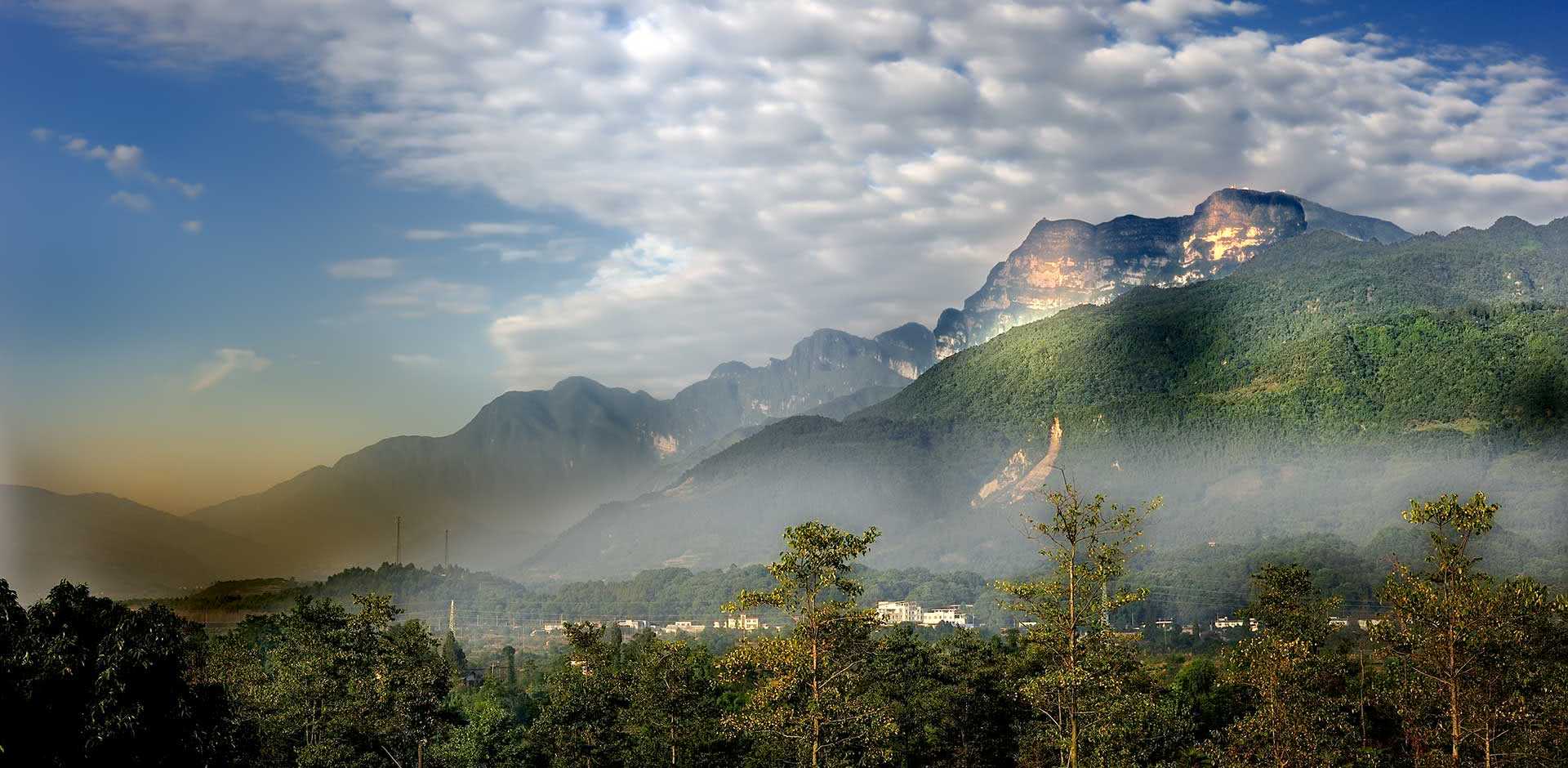
Mount Emei.
Main Highlights: What You Absolutely Can’t Miss
Mount Emei, a jewel in Sichuan Province, is renowned for its stunning landscapes and rich Buddhist heritage. This UNESCO World Cultural and Natural Heritage site is a must-visit for international travelers seeking a blend of natural beauty and cultural depth. Here are the highlights you absolutely can’t miss during your exploration of this majestic mountain.
Baoguo Temple
Start your journey at Baoguo Temple, the gateway to Mount Emei. Nestled at an altitude of 551 meters, this temple is a hub of Buddhist activity and houses a rich collection of cultural relics. As the first temple you encounter, its serene ambiance and beautiful architecture set the tone for your visit. Don’t miss the Cultural Relics Management Office here, which showcases a fascinating array of artifacts from ancient ceramics to weapons dating back to the Warring States Period.
Golden Summit (Jinding)
Ascend to the iconic Golden Summit, standing proudly at 3,079 meters. This peak is the crown jewel of Mount Emei, offering breathtaking views of sunrises, seas of clouds, and the awe-inspiring 48-meter golden statue of Samantabhadra Bodhisattva. The summit’s atmosphere, especially at dawn, is ethereal as the morning sun casts its golden hue over the landscape. Be prepared for an unforgettable experience that feels like touching the heavens.
Wannian Temple
A visit to Wannian Temple, one of the oldest temples on the mountain, is essential. Established during the Eastern Jin Dynasty, it features a beamless brick hall that is an architectural wonder. The temple is home to several priceless treasures, including a legendary Buddha’s tooth and ancient palm-leaf scriptures from Thailand. The rich history and serene surroundings make this temple a highlight of your visit.
Qingyin Pavilion
Positioned beautifully between the Heilong and Bailong Rivers, Qingyin Pavilion is a picturesque spot that exemplifies the harmony between man and nature. Its quaint structure, surrounded by lush forests, offers a tranquil retreat. The peaceful atmosphere and scenic views make it an ideal place for reflection and relaxation.
Ecological Monkey Zone
A unique and lively experience awaits you at the Ecological Monkey Zone, the largest of its kind in China. Home to over 1,000 monkeys, this area is a playful reminder of nature’s wild side. As you explore, be cautious with your food; these cheeky monkeys are known to snatch snacks right from your hands! Observing their antics provides a delightful contrast to the mountain’s serene temples.
Hiking Trails
For those eager to embrace the mountain’s natural beauty, various hiking routes cater to all levels of fitness. The 1-day and 2-day hiking itineraries allow you to explore the temples, scenic spots, and breathtaking vistas at your own pace. Whether you choose to hike or take advantage of the cable cars, the views along the trails are simply stunning.
Hot Spring Spa
After a day of hiking and exploring, indulge in the ultimate relaxation at Hot Spring Happy Valley, the largest hot spring theme park in China. With numerous pools nestled in a lush forest, soaking in the radon hot spring water is the perfect way to unwind and rejuvenate.
Skiing at Leidongping Ski Resort
For winter visitors, the Leidongping Ski Resort offers a thrilling skiing experience in an alpine setting. With good snowfall from October to March, this resort is the largest in Southwest China, featuring various activities from skiing to dog sledding. Enjoy the snowy landscapes and exhilarating sports during your visit.
Tea Picking Experience
If you’re visiting between March and early June, don’t miss the opportunity to participate in tea picking in the beautiful tea gardens of Mount Emei. This experience not only immerses you in local culture but also allows you to enjoy the stunning views and learn about the exquisite Xueya green tea.
Conclusion
Mount Emei is a treasure trove of experiences that seamlessly blend nature, spirituality, and adventure. From the tranquil temples steeped in history to the breathtaking views from the peaks, every moment spent on this mountain is sure to leave you in awe. Make sure to carve out enough time to savor each of these highlights, as they collectively embody the essence of Mount Emei.
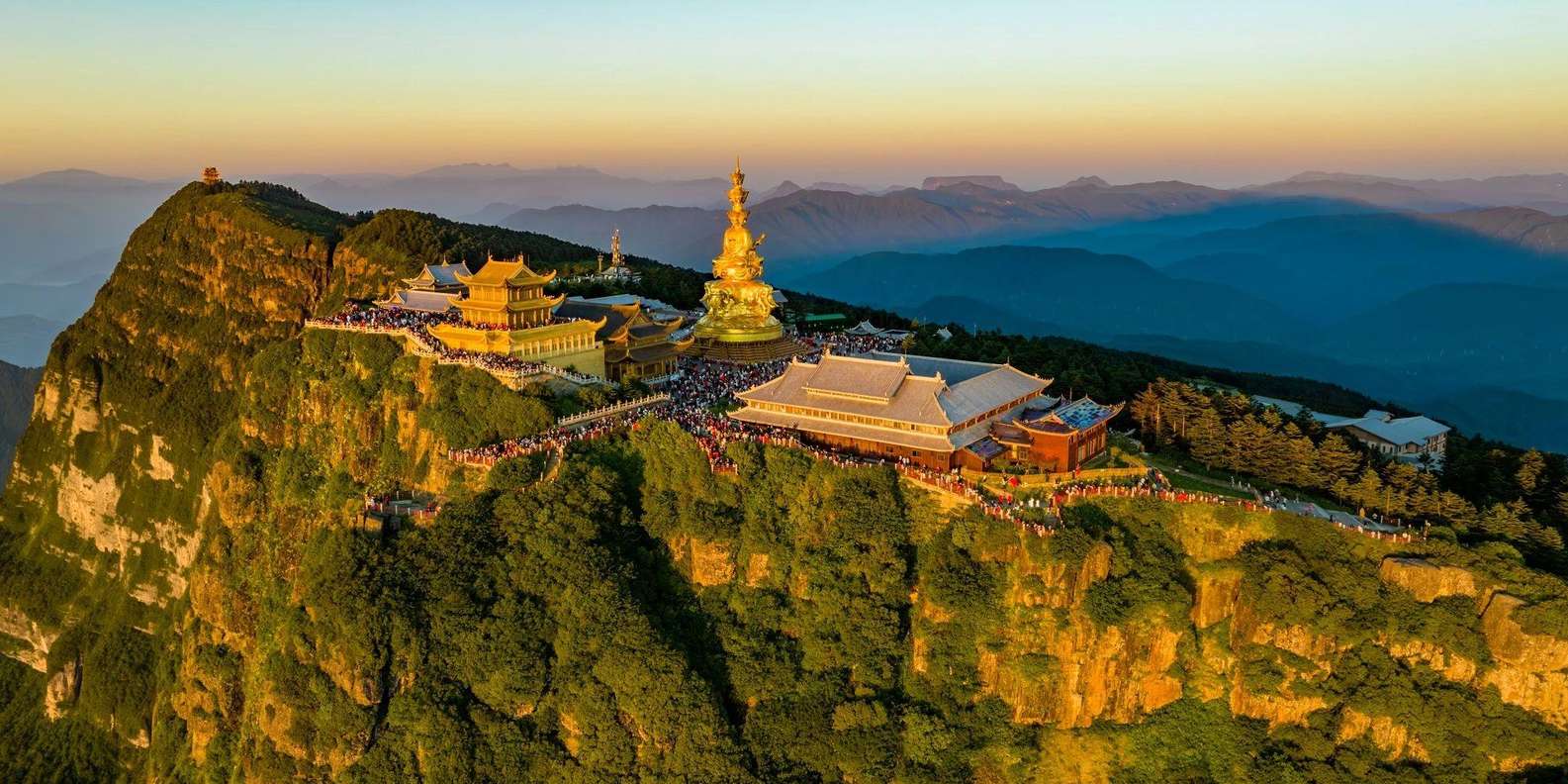
Mount Emei.
Planning Your Visit: A Practical Guide
Practical Guide for Your Visit to Mount Emei
Mount Emei, renowned for its breathtaking scenery and rich Buddhist heritage, is a destination that deserves thoughtful planning to make the most of your visit. Whether you’re drawn by the allure of its temples, the challenge of its hiking trails, or the tranquility of its hot springs, this guide will help you navigate your adventure seamlessly.
Getting There
From Chengdu
- By High-Speed Train: The quickest way to reach Mount Emei is by taking a bullet train from Chengdu East Railway Station to Emeishan Railway Station, which takes about 1 hour and 20 minutes. Once you arrive, you can take a local bus or a taxi (approximately 20 minutes) to the scenic area entrance at Baoguo Temple.
- By Long-Distance Bus: Alternatively, you can take a bus from Chengdu Xinnanmen Bus Station, which takes about 2.5 hours. Buses operate frequently from 6:40 AM to 7:20 PM.
From Leshan
- By Train: If you’re coming from Leshan, the high-speed train from Leshan Railway Station to Emeishan Railway Station takes about 15 minutes.
- By Bus: Direct buses from Leshan Central Bus Station or Xiaoba Bus Station to Emeishan take roughly 30 minutes.
Navigating Mount Emei
Once inside the scenic area, you’ll find a variety of transportation options to help you explore:
– Sightseeing Buses: These connect major attractions like Baoguo Temple, Wuxiangang, and the cable car stations for Golden Summit and Wannian Temple.
– Cable Cars: Use the Golden Summit Cable Car from Jieyin Hall to reach the summit or the Wannian Temple Cable Car from the parking lot.
– Walking & Hiking: For the more adventurous, many visitors enjoy walking between temples and natural sights, especially from Baoguo Temple to Qingyin Pavilion or the Ecological Monkey Zone.
Accommodation Options
Mount Emei caters to a variety of budgets and preferences:
– Baoguo Temple Area: Perfect for easy access to transport, restaurants, and hot springs. Options range from budget hostels to mid-range hotels and luxury resorts, all within a 5-10 minute drive to the scenic area entrance.
– Leidongping Area: Ideal for those wanting to see the sunrise or sea of clouds with minimal hiking. Note that accommodation here is limited and tends to fill up quickly during peak seasons, so book in advance.
– Temple Lodging: Experience the unique culture of Mount Emei by staying in one of the temples, such as Baoguo Temple. Accommodations are simple and affordable, allowing guests to partake in early morning chanting and vegetarian meals.
Best Time to Visit
The ideal times to visit Mount Emei are during the spring (April to June) and autumn (September to November) months, when the weather is mild and the scenery is vibrant. Here are some highlights to consider:
– Sunrise: Best viewed around 6:00 AM in summer and 7:00 AM in winter.
– Sea of Clouds: Look for this spectacle between 9:00-10:00 AM and 3:00-4:00 PM.
– Buddha’s Halo: This phenomenon can also be observed during the same morning and afternoon time slots.
– Skiing: If you’re keen on winter sports, visit from November through March, when the snow is thickest.
Activities to Enjoy
Mount Emei is not just about sightseeing; it offers various activities:
– Hiking: Engage in some incredible hiking. Choose from a one-day route that covers major sights or a two-day trek for a more immersive experience.
– Hot Springs: After a long hike, unwind at Hot Spring Happy Valley, the largest hot spring theme park in China, featuring 153 pools.
– Tea Picking: From March to early June, partake in the local tradition of tea picking in the beautiful tea gardens.
– Skiing: For winter enthusiasts, Leidongping Ski Resort offers skiing and other winter activities.
Final Tips
- Prepare for Weather Variability: Due to its varying altitude, be ready for shifts in weather. Pack layers to stay comfortable.
- Conceal Food: If you’re planning to explore the Ecological Monkey Zone, keep food hidden, as the monkeys are known to be quite cheeky.
- Respect the Culture: As a site of significant Buddhist practice, be mindful of the local customs and the monks’ daily routines.
With its stunning landscapes, rich traditions, and a plethora of activities, Mount Emei promises a memorable experience for every traveler. Whether you’re seeking adventure or tranquility, this majestic mountain has something special for you. Enjoy your visit!
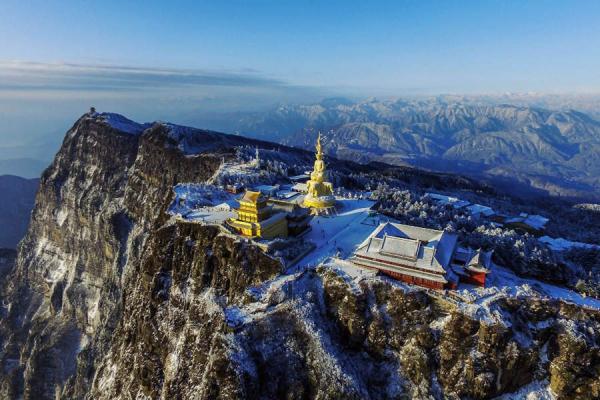
Mount Emei.
Tickets: Prices, Booking, and Tips
Visiting Mount Emei is a remarkable experience, and planning your ticket purchases wisely can enhance your journey. Here’s everything you need to know about ticket prices, booking options, and some handy tips to make the most of your visit.
Ticket Prices
Mount Emei has a tiered pricing structure that varies depending on the season:
- Low Season (December to January): 110 RMB
- High Season (February to November): 160 RMB
Keep in mind that these prices only cover entrance to the mountain. Additional fees apply for cable cars and sightseeing buses, which are essential for navigating the various attractions throughout the mountain.
Booking Tickets
Tickets for Mount Emei can be purchased in several ways:
- On-Site Purchase: You can buy tickets directly at the entrance, but this may involve waiting in line, especially during peak tourist seasons.
- Online Booking: For convenience, consider booking your tickets online through various travel platforms or the official Mount Emei website. This can save you time and ensure your entry, especially during busy months.
- Guided Tours: Many travelers opt for guided tours that include transportation, entrance fees, and sometimes meals. These packages can simplify the planning process and often provide valuable insights from local guides.
Tips for Visiting
-
Plan Your Visit: It’s advisable to spend at least 2 to 3 days at Mount Emei to fully appreciate its beauty and cultural significance. This allows ample time to explore the temples, hiking trails, and the stunning views from the summit.
-
Timing is Key: To catch breathtaking sunrises or the elusive sea of clouds, plan your hikes early in the morning. Depending on the season, sunrises occur around 6:00 AM in summer and 7:00 AM in winter.
-
Prepare for Weather Changes: The climate at Mount Emei can change dramatically with altitude. Dress in layers and be prepared for mist or rain, as the mountain is shrouded in fog for about 320 days a year.
-
Food and Drink: Make sure to bring snacks and plenty of water, as food options can be limited on the mountain. However, bear in mind that the monkeys in the Ecological Monkey Zone are known for their cheeky behavior and may try to snatch your food!
-
Stay Overnight: Consider staying in one of the temples or guesthouses on the mountain for a unique experience. This not only gives you a chance to enjoy serene mornings but also allows for more flexibility in your exploration schedule.
By keeping these tips in mind and planning ahead, you’ll be well-equipped to enjoy the breathtaking beauty and rich culture of Mount Emei. Happy travels!
How to Get There: A Complete Transportation Guide
Getting to Mount Emei is an adventure in itself, and travelers will find that reaching this stunning Buddhist mountain is both convenient and scenic. Below is a detailed guide on how to navigate your way to this UNESCO World Heritage site, whether you’re coming from Chengdu, Leshan, or exploring the area beyond.
From Chengdu
By High-Speed Train
One of the quickest and most comfortable ways to reach Mount Emei is by high-speed train. Trains depart frequently from Chengdu East Railway Station to Emeishan Railway Station, taking approximately 1 hour and 20 minutes. Once you arrive at Emeishan Railway Station, you can take a local bus or a direct taxi (about 20 minutes) to the entrance of the scenic area at Baoguo Temple.
By Long-Distance Bus
If you prefer traveling by bus, head to either Chengdu East Bus Station or Shiyangchang Bus Station. The journey to the Emeishan Scenic Area Bus Station takes around 2.5 hours, with buses running every hour from 06:40 to 19:20. This option offers a chance to see the countryside as you travel.
From Leshan
By Train
Travelers coming from Leshan can take advantage of the high-speed train service, with trains departing from Leshan Railway Station to Emeishan Railway Station in about 15 minutes. This quick trip makes it easy to combine visits to both the Leshan Giant Buddha and Mount Emei in one day.
By Bus
Direct buses are also available from Leshan Central Bus Station or Xiaoba Bus Station to the Emeishan Transportation Center, with a journey time of approximately 30 minutes. This is a convenient and affordable option for visitors staying in Leshan.
Getting Around Mount Emei
Once you arrive at Mount Emei, you’ll find that exploring the scenic area can be done in several enjoyable ways:
Sightseeing Buses
A network of sightseeing buses connects major scenic points, including Baoguo Temple, Wuxiangang, Wannian Temple, Leidongping, and the Golden Summit cable car station. This is a great way to cover larger distances while enjoying the beautiful surroundings.
Cable Cars
For those looking to save energy for hiking or simply wanting to enjoy the views, cable cars are available:
– Golden Summit Cable Car: From Jieyin Hall to Golden Summit.
– Wannian Temple Cable Car: From the parking lot to Wannian Temple.
Walking and Hiking
Many visitors choose to walk between the temples and natural attractions, particularly the scenic route from Baoguo Temple up to Qingyin Pavilion or the Ecological Monkey Zone. This allows for a more immersive experience in the tranquil beauty of Mount Emei.
Accommodation Options
Mount Emei caters to various budgets and preferences, making it easy to find a place to stay:
-
Baoguo Temple Area: The best option for those arriving late, offering easy access to transport, restaurants, and hot springs. A variety of accommodations are available, from budget hostels to luxury resorts.
-
Leidongping Area: Perfect for those wanting to catch the sunrise or sea of clouds without a strenuous morning hike. However, accommodation options here are limited, so booking in advance is essential during peak seasons.
-
Temple Lodging: For a unique cultural experience, consider staying in one of the temples, such as Baoguo Temple. This option provides simple and affordable accommodations along with the experience of early morning chanting and vegetarian meals.
Conclusion
Reaching Mount Emei is straightforward, whether you choose the speed of a train, the convenience of a bus, or the scenic routes available once you arrive. With various options for accommodation and transportation within the mountain, your journey to this breathtaking destination will be both enjoyable and memorable. Don’t forget to pack your sense of adventure and a camera to capture the stunning views!

Mount Emei.
Local Cuisine and Accommodation Nearby
When visiting the magnificent Mount Emei, indulging in local cuisine and finding the perfect place to stay can significantly enhance your experience. Here’s a guide to some delightful dining options and accommodation choices that cater to every traveler’s needs.
Culinary Delights Around Mount Emei
Local Specialties
-
Emei Tofu – Known for its smooth texture and rich flavor, Emei tofu is a must-try delicacy. Often served in hot pots or stir-fried with seasonal vegetables, it provides a wholesome meal after a day of hiking.
-
Sichuan Hot Pot – Embrace the bold flavors of Sichuan cuisine by indulging in a spicy hot pot. Numerous restaurants around Mount Emei offer this communal dining experience, where you can cook fresh ingredients to your liking in a bubbling broth.
-
Buddhist Vegetarian Cuisine – With Mount Emei being a prominent Buddhist site, many temples such as Baoguo Temple serve exquisite vegetarian meals. Enjoy dishes crafted from fresh, local ingredients, featuring everything from stir-fried greens to hearty grain bowls.
-
Wild Mushroom Dishes – The region is famous for its abundant wild mushrooms. Look for restaurants that serve mushroom soup or stir-fried mushrooms, a delightful treat that showcases the local harvest.
Dining Venues
- Emei Mountain Restaurant: Located near Baoguo Temple, this restaurant offers a great selection of local Sichuan dishes, including tofu and mushroom specialties. The ambiance is warm and inviting, perfect for weary hikers.
- Qingyin Pavilion Restaurant: Nestled in a picturesque setting, this eatery provides stunning views along with delicious vegetarian options. It’s an ideal spot to relax and recharge after exploring the nearby attractions.
- Emei Hot Spring Resort Dining: After a day of hiking, consider dining at the Hot Spring Happy Valley. It features a range of international and local dishes, all while you unwind in a relaxing environment.
Where to Stay
Accommodation Options
- Baoguo Temple Area:
-
This area is perfect for those seeking convenience. With options ranging from budget hostels to mid-range hotels, you’ll find accommodations suitable for any budget. Enjoy easy access to restaurants, hot springs, and the scenic area entrance, just a short drive away.
-
Leidongping Area:
-
If catching the sunrise at Golden Summit is on your agenda, consider staying in Leidongping. While the options are limited, there are charming guesthouses and basic hotels that provide a cozy atmosphere. Be sure to book in advance during peak seasons, as they fill up quickly.
-
Temple Lodging:
-
For a truly unique experience, consider staying at one of the temples like Baoguo Temple. These simple accommodations offer an immersive cultural experience, including early morning chanting and vegetarian meals. It’s a spiritual and tranquil way to connect with the mountain’s heritage.
-
Emei Mountain Resort:
- For those desiring a more luxurious stay, the Emei Mountain Resort provides comfortable rooms with modern amenities. Enjoy stunning views of the mountain and indulge in spa treatments after a long day of exploration.
Final Thoughts
Whether you’re savoring the flavors of Sichuan cuisine or choosing a cozy place to rest after your adventures, the area around Mount Emei offers a variety of options to enhance your visit. Embrace the local culture, and make your journey to this UNESCO World Heritage site not just a hike, but a full sensory experience!
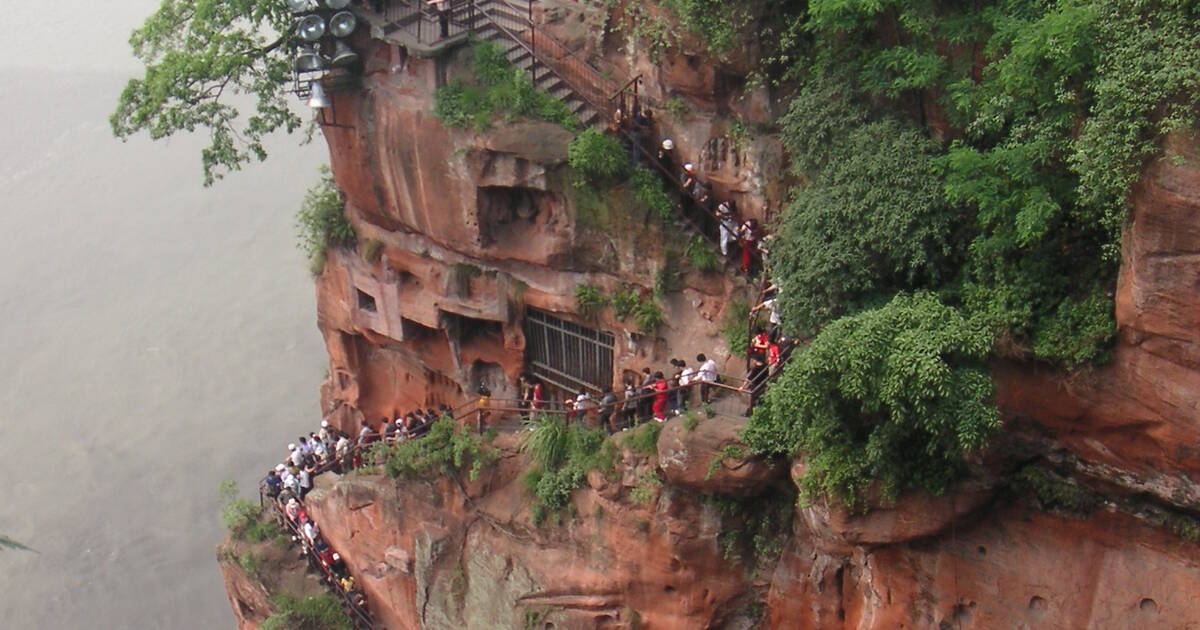
Mount Emei.
Frequently Asked Questions
Frequently Asked Questions about Mount Emei
1. What is the best time of year to visit Mount Emei?
The ideal times to visit Mount Emei are during the spring (April to June) and autumn (September to November) when the weather is mild and the scenery is vibrant. If you’re interested in snow activities, consider visiting during winter (November to March).
2. How do I get to Mount Emei from Chengdu?
You can easily reach Mount Emei from Chengdu via high-speed train, which takes about 1 hour and 20 minutes from Chengdu East Railway Station to Emeishan Railway Station. Alternatively, buses run regularly from Chengdu Xinnanmen Bus Station and take approximately 2.5 hours.
3. Are there accommodation options available on Mount Emei?
Yes, Mount Emei offers a variety of accommodations ranging from budget hostels to mid-range hotels and luxurious resorts. You can also stay at temples for a unique cultural experience, but it’s best to book in advance during peak seasons.
4. What are the main attractions on Mount Emei?
Must-see attractions include Baoguo Temple, the Golden Summit, Wannian Temple, Qingyin Pavilion, and the Ecological Monkey Zone. Each site offers unique cultural and natural experiences, so plan your itinerary accordingly!
5. What activities can I enjoy while visiting Mount Emei?
Visitors can indulge in hiking, exploring temples, enjoying hot springs, picking tea leaves, or even skiing at the Leidongping Ski Resort during winter. There’s something for everyone, depending on the season you choose to visit!
6. How much do tickets cost to enter Mount Emei?
Ticket prices vary by season; during low season (December to January), tickets are priced at 110 RMB, while high season (February to November) costs 160 RMB. Note that separate fees apply for cable cars and sightseeing buses.
7. Is it safe to hike around Mount Emei?
Yes, hiking on Mount Emei is generally safe, but it’s important to wear appropriate footwear and be mindful of your physical limits. Trails can vary in difficulty, so choose a route that matches your fitness level.
8. What should I know about the monkeys in the Ecological Monkey Zone?
The Ecological Monkey Zone is home to over 1,000 monkeys that are known to be quite bold around tourists. It’s advisable to avoid eating in their presence and to keep your food concealed to prevent any unexpected interactions!
Final Thoughts on Your Trip
As your adventure at Mount Emei draws to a close, take a moment to reflect on the myriad experiences this magnificent mountain has offered. From the tranquil serenity of ancient temples steeped in Buddhist heritage to the breathtaking vistas atop the Golden Summit, every step along the winding trails has unveiled a new layer of natural beauty and spiritual depth. Whether you were captivated by the playful monkeys in the Ecological Monkey Zone, indulged in the soothing embrace of a hot spring, or immersed yourself in the local tea culture, Mount Emei is a destination that nourishes the soul.
This journey isn’t just about the sights; it’s about the moments that linger in your memory—the crisp mountain air, the laughter shared with fellow travelers, and the quiet contemplation sparked by nature’s splendor. As you descend from this sacred peak, carry with you the tranquility and inspiration that Mount Emei embodies. Each visit leaves an indelible mark, inviting you to return and explore its wonders anew.
So, until next time, may your travels continue to bring you closer to the beauty of our world, and may the spirit of Mount Emei inspire you in your future adventures. Safe travels!